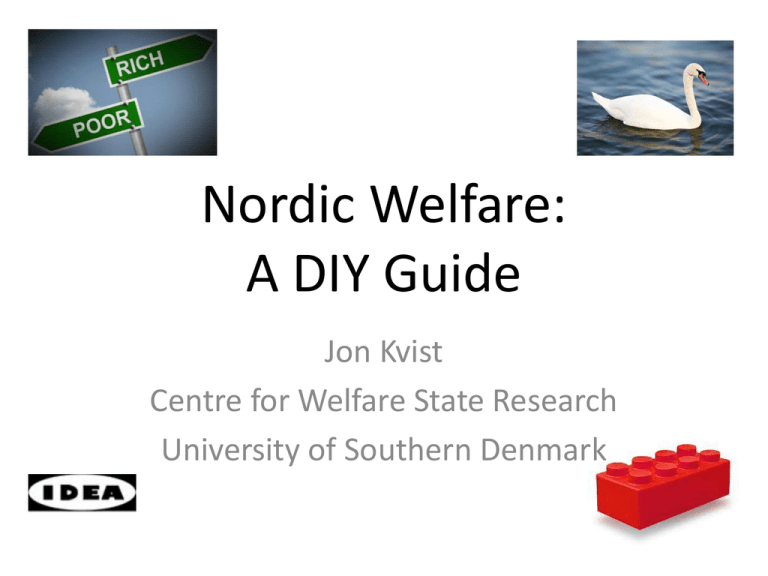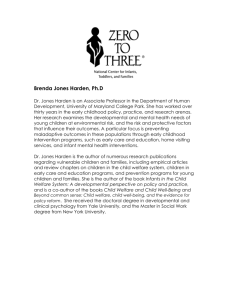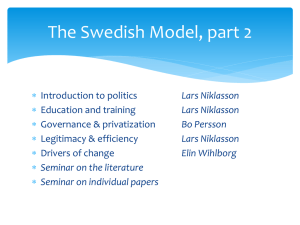Employment-friendly workfare policies – Experiences from Denmark
advertisement

Nordic Welfare: A DIY Guide Jon Kvist Centre for Welfare State Research University of Southern Denmark Denmark – the land of fairytales and LEGO High equality Between rich and poor Between men and women Incomes Employment Earnings Subjective measures High employment For all Particularly for women The higher the skills, the higher the employment High employment is important: - To increase welfare - To finance welfare Without high employment, no “welfairytale” how to make the welfare model employment-friendly? Question: The Welfare Puzzle Generous cash benefits ≠ = High taxes Low wage inequality High employment Answer: Employment-friendly policies Activation requirement polices moral hazard Encompassing labour, social, educational and health services that helps to create, maintain and utilize human capital Nordic approach • Goal is to maximise the realization of human capital for all • Almost all public policies are directed towards increasing work • Welfare model not only about securing a safety net or providing insurance and compensation, but also social investments Social investments over the life course Childhood Youth Fertille Working age Old Social investments: Example of policies Early childhood education and care Childhood Primary, secondary and tertiary education Youth Care for children and elderly, leave schemes Fertille Life-long learning, ALMP Working age Home help, health care Old Social investments: Returns Rate of return Cognitive skills Competences and knowledge Children Skills and taxes Less expenses Childhood Youth Fertile Working aged Old age The Welfare Circus (Re)distribution Insurance Social investments Safety Equity versus efficiency Standard focus Negative trade-off through distortions from redistributive policies Scandinavian focus 1. Insurance promotes risk behaviour 2. Human capital investments increase qualifications 3. Cash benefits are automatic stabilizers 4. Moral hazard can be policed Life satisfaction UK DK Organisation of welfare services State Authority to tax Legislate on cash benefits Tertiary education Regions (5) Municipalities (98) No authority to tax Health services Authority to tax Social services - Childcare - Elderly care Education Employment services Some health services In part reimbursed in part by state for cash benefits Inter-municipal redistribution Active labour market policies Workfare intensity Targetted programmes: Training Education Short programmes Counciling Job search courses Job search Contact to job exchange Duration of unemployment spell Changing demographics G B R • Changing household composition • Ageing populations • More ethnic diverse populations Maternal employment rate (youngest child 6-14 years) 95 Challenges 80 • (Re)conciliation of work and family life • Less people to care and finance more elderly • Maintain solidarity 65 50 35 20 DK Employment rate of females (25-54 years), 2009 Trust in others GBR 70 60 50 40 30 20 10 0 DK The way we combine Lego bricks constitute our welfare societies Employment protection ÷ + ÷ Social security + ÷ Active labour market policies + + ÷ Social services + ÷ ÷ …. AND THUS THEIR SOCIAL AND ECONOMIC SUSTAINABILITY ÷ Lego bricks in the Danish model Employment protection legislation Active labour market policy Social security Social services Lax Rights and duties Encompassing Accessible, good quality childcare Contact and talks Generous for low income groups Encompassing elderly care Job subsidy In-work training Courses and education Sanctions In short • By whom, where and when you are born matters for your life chances • No big trade-off between efficiency and equity • Social security provide redistribution and insurance • Activation polices moral hazard • The effects of active labour market policies depends on; economic cycle; type of instrument and target group, program length, sequencing and timing; etc. • Social investments crucial, especially in: – Knowledge based societies - People before they become adults - Kids with disadvantaged family backgrounds Is the Nordic model sustainable? • Maintain high employment rates • Avoid increase in long term unemployment and marginalization • Not new challenges, but changing focus and forms • Other forms of equality: gender, age, persons with handicaps and illness, ethnicity, regional etc. • Social investments more needed than ever Crisis perspectives Cohort effects Intergenerational effects European polarization Labour market polarization Nordic model here to stay Thanks for your attention Good luck with the Scottish Model! www.jonkvist.com










